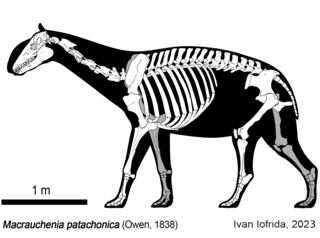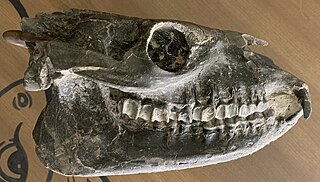
Paucituberculata is an order of South American marsupials. Although currently represented only by the seven living species of shrew opossums, this order was formerly much more diverse, with more than 60 extinct species named from the fossil record, particularly from the late Oligocene to early Miocene epochs. The earliest paucituberculatans date to the late Paleocene. The group went through a pronounced decline in the middle Miocene epoch, which resulted in the extinction of all families of this order except for the living shrew opossums (Caenolestidae). Extinct families of Paucituberculatans include Pichipilidae, Palaeothentidae, and Abderitidae.

Macraucheniidae is a family in the extinct South American ungulate order Litopterna, that resembled camelids. They had three functional digits on the fore and hind feet, as well as elongate necks. The family is generally divided up into two subfamilies, Cramaucheniinae and Macraucheniinae. The family shows retraction of the nasal region, most extremely to the top of the skull in derived macraucheniine taxa like Macrauchenia. which has been interpreted to have supported a probsocis, perhaps like that of a saiga antelope to filter dust, or a moose-like prehensile lip. The earliest unambiguous members of the family date to the late Oligocene around 30 million years ago. Polymorphis from the Eocene has historically been placed as a macraucheniid, but this has been doubted. Most early representatives had a body masses in the range of 80–120 kilograms (180–260 lb), though some like Llullataruca were as small as 35–55 kilograms (77–121 lb), and the last representatives of the family from the Pleistocene like Macrauchenia were over 1,000 kilograms (2,200 lb). The family reached its apex of diversity during the late Miocene around 10-6 million years ago, before declining to only a few species belong to the genera Macrauchenia and Xenorhinotherium by the Late Pleistocene.

Peltephilus, the horned armadillo, is an extinct genus of armadillo xenarthran mammals that first inhabited Argentina during the Oligocene epoch, and became extinct in the Miocene epoch. Notably, the scutes on its head were so developed that they formed horns. Aside from the horned gophers of North America, it is the only known fossorial horned mammal. P. ferox had skull about 11.7 centimetres (4.6 in), and estimated body mass is around 11.07 kilograms (24.4 lb).

Hapalops is an extinct genus of ground sloth from the Early to Late Miocene of Brazil, Bolivia, Colombia, and Argentina in South America.

Diadiaphorus is an extinct genus of litoptern mammal from the Miocene of Argentina and Bolivia, South America.

Theosodon is an extinct genus of litoptern mammal from the Early to Middle Miocene of South America.
Guiomys is an extinct genus of cavioid rodent which lived in west central Patagonia of Argentina, Bolivia and Peru during the Middle Miocene (Laventan). Guiomys is known from mandibular and maxillary fragments with molars, and isolated cheek teeth. It was first named by María E. Pérez in 2010 and the type species is Guiomys unica.

Proterotheriidae is an extinct family of litoptern ungulates known from the Eocene-Late Pleistocene of South America. Members of the group were small-medium sized cursorial herbivores with brachydont teeth, with their toes showing progressive reduction, with later members of the group bearing weight on a single large toe similar to living horses.

Granastrapotherium is an extinct genus of ungulate mammals, described from remains found in rocks of the Honda Group in the Tatacoa Desert, in the Colombian departments of Huila and Tolima, at the Miocene fossil site La Venta. The only species formally recognized is Granastrapotherium snorki. Remains found in Bolivia and Peru, seem to belong to Granastrapotherium or a very similar animal.

Xenastrapotherium is an extinct genus of astrapothere, a type of hoofed herbivorous mammal, native to South America, which lived in the Middle to Late Miocene period, typically during the Laventan stage. It is a member of the family Astrapotheriidae in the subfamily Uruguaytheriinae, large astrapotheres, equipped with a trunk-like nose and protruding teeth, similar to the elephants, but their tusks were the canine teeth, not the incisors. Xenastrapotherium was a genus widely distributed in northern South America, in contrast to other species of astrapotheres which lived in the area of the Southern Cone of the continent. It differed from other astrapotheres by having two lower incisors on each side of the jaw and the tusks have a pronounced longitudinal curvature, although their general shape and size are probably very similar to Astrapotherium, whose weight would be 900 to 1,500 kilograms, comparable to the current black rhinoceros.
Hiskatherium is an extinct genus of small ground sloth from the Middle Miocene Honda Group of Bolivia. The type species H. saintandrei was named in 2011 on the basis of a lower jaw. Although it has not been placed in a specific family, Hiskatherium is similar to the extinct sloths Hapalops and Xyophorus.
Miocallicebus is an extinct genus of New World monkeys from the Middle Miocene. Its remains have been found at the Konzentrat-Lagerstätte of La Venta in the Honda Group of Colombia. The type species is Miocallicebus villaviejai.

Miocochilius is an extinct genus of small notoungulate mammals (typotheres) native to South America. The genus lived during the Middle Miocene epoch. The genus contains two described species, the type species M. anomopodus described in 1953 by Ruben Arthur Stirton and M. federicoi, described and included in the genus by Darin A. Croft.
Paratrigodon is an extinct genus notoungulate belonging to the subfamily Toxodontinae, containing one species, P. euguii. Like its close relative Trigodon, it is known for the presence of a horn-like protuberance on its forehead. Fossils of Paratrigodon are known from the Arroyo Chasicó Formation dating from the Chasicoan period, and teeth from the Laventan-aged Quebrada Honda Fauna of Bolivia were also associated with the genus, although considered too different from the type species to be assigned to it.

Cramaucheniinae is a paraphyletic subfamily of macraucheniids that originated in the middle Eocene. The size range of the group ranged from small, basal forms to larger and more derived forms. During their evolution, the cramaucheniines undergone a trend from evolving from small basal forms such as Polymorphis into larger, more derived taxa such as Theosodon.
Promacrauchenia is an extinct genus of macraucheniids that lived during the Late Miocene to Late Pliocene epochs of what is now Argentina and Bolivia. It belongs to the subfamily Macraucheniinae, which also includes Huayqueriana, Macrauchenia, and Xenorhinotherium. Fossils of this genus have been found in the Ituzaingó, Andalhuala, and Cerro Azul Formations of Argentina.
Llullataruca is an extinct genus of macraucheniid litoptern. It lived during the Middle Miocene of what is now Bolivia.
Uruguayodon is an extinct genus of proterotheriid from the middle Pleistocene of Uruguay. It is known from the type and only species U. alius, named by Corona and colleagues in 2019 for dentaries and a partial postcrania from the Raigón Formation. Uruguayodon represents one of the latest occurrences of Proterotheriidae, with only Neolicaphrium representing other remains from the Pleistocene to possibly Holocene.
Prolicaphrium is an extinct genus of proterotheriid litoptern that lived during the Early Miocene, in what is now Argentina. Fossils have been found in the Sarmiento Formation of Argentina.
Pternoconius is an extinct genus of macraucheniid litoptern from the Late Oligocene and Early Miocene of Argentina. Fossils of this genus have been found in the Sarmiento Formation of Argentina.














